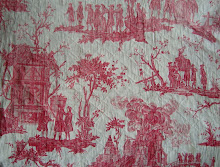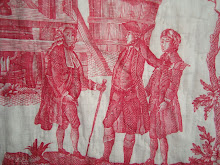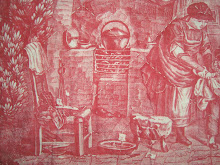





Here is the next installment of this slowly unfolding textile story. I haven't done any more to the quilt since the first post, as I am not quite sure how to procced, I had intended to remove the whole back panel to see the full extent of the damage and reveal the fabrics beneath the outer layer, but I may be a bit more 'archaeological' about it, if you know what I mean, and 'dig a trench' or two across particular areas and see what I find! I would appreciate your thoughts on the subject before I unpick any more.
Here are close-ups of some of the very damaged parts to see the beautiful fabric revealed so far below the green and cream side! Please click on each piece to enlarge, the detail is exquisite! It looks like an first layer of fine, small print indienne cotton in a caramelly-pink, with roses, and some sort of geomtric strap-work/cartouche motif. Beneath that is another indienne, it must be earlier, in more of a raspberry reddish-pink with the tiniest rose print. Finally, what looks like a patch, rather than a layer of a striped fabric. This was seen on the other side of the quilt, through some damage to the wool batting, so was beneath the deep red/faded clack floral twill side, unlike the two cottons. This looks hand woven wool to me at this stage, perhaps a piece of tapestry. What do you think?
I won't try to date the fabric yet, I need to look through some of my books to do some research, as I am certainly no expert, just a very enthusiastic amateur, but have lots of books, the internet and the odd bout of Sherlock Holmsian doggedness when presented with a puzzle like this! Please let me know if you have any ideas, lets pool our resources here girls!
I won't try to date the fabric yet, I need to look through some of my books to do some research, as I am certainly no expert, just a very enthusiastic amateur, but have lots of books, the internet and the odd bout of Sherlock Holmsian doggedness when presented with a puzzle like this! Please let me know if you have any ideas, lets pool our resources here girls!



















































































I would give anything to be sitting beside you as you work on this piece. I think your idea of a "archeological dig" is perfect. These are the projects that make my heart beat faster! Such incredible textiles you are unearthing. I really think that you know more than you give yourself credit for knowing. These are the projects that teach and we assimilate so much information simply by observation and trial and error. I also think it would be great if you made samples of these pieces and documented them for future reference. (You could write a book!).
ReplyDeleteI find the wool batting so fascinating too. I am very excited about your work and am anxious to see the documentation. I love all these wonderful pieces with their worn parts and faded colors. I encourage you to go over to spiritcloth.typepad.com and view her post and make a comment on what you are doing. She would be fascinated by this. Her "new" quilts are amazing with all the many layers and reminds me of this piece. If you don't want to do this I would be glad to reference you on my blog if you would like. This is great and should not be missed. Thank you for such a great blog.
Thank you once again for your lovely, flattering comments. I am glad we share the same enthusiasm for the project, and wish you could be here to share the experience! I have looked at the site you recommend, it is wonderful, I love the way she mixes her musings with the story in each piece of fabric, no wonder her work is so inspired. I am a little shy, perhaps you could point her in this direction! More on the quilt in a day or two. Enjoy your road Trip! xx
ReplyDeleteIn the first photo, the jewel seems to be connected to the cartouche by links - is it hanging? And if so, is the fabric upside down? It would be interesting to see the photo rotated. The foliage looks a bit like ironwork. Can you find more of the red flowers underneath? What I can see in the photo is so tantalizing...
ReplyDeleteAnd I really like the archaeological imagery!!
ReplyDeleteHow interesting! I think you are right, I hadn't noticed that! I shall see if I can find a piece of the 'cartouche & jewel' pattern to photograph the other way round for the next post, now you mention it it seems really obvious, and that type of design may help with dating that particular fabric, it looks kind of neo-classical, so may be about 1850, perhaps a bit earlier. I shall look forward to more astute observations from you! Many thanks xx.
ReplyDelete